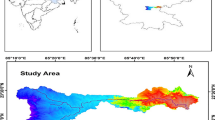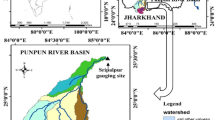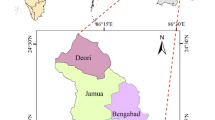Abstract
In the present study, the Soil and Water Assessment Tool was applied to determine the impacts of changing Land Use and Land Cover (LULC), Geophysical Fluid Dynamics Laboratory – Earth System Model Version 2, and Representative Concentration Pathways (RCP) 8.5 climate scenario on the monthly streamflow in the Subarnarekha basin of India. The results showed increased flow due to a reduction in agricultural area, a rise in built-up area, and a reduction in water bodies due to LULC change. In addition, lower annual precipitation and increased projected temperature were observed under RCP8.5. Although annual precipitation is decreasing, some components of the water balance are slightly increasing. From 2013 to 2020, surface flow increased by 98.85 mm and water yield decreased by 13.33 mm. However, in the climate change scenario, surface flow increased by 142.85 mm. Water yield decreased by 21.88 mm, lateral flow slightly decreased by 7.06 mm, and a further significant decrease 68.37% was noted in groundwater flow. The downward trend in groundwater flow is a serious concern, and therefore, more surface water storage structures must be planned to increase groundwater recharge and capture the increased surface flow. The model performance was statistically tested for NSE (Nash–Sutcliffe efficiency), R2, and PBIAS (percent bias). During the calibration period and validation stages, NSE, R2, and PBIAS were found to be 0.72, 0.83, and − 15.20%, and 0.85, 0.82, and − 27%, respectively, with the 2013 LULC map. The decreased monthly water availability and declining trend of winter rainfall need to be taken care of while planning the cropping pattern of the basin.













Similar content being viewed by others
References
Abbaspour, K. C., Yang, J., Maximov, I., Siber, R., Bogner, K., Mieleitner, J., Zobrist, J., & Srinivasan, R. (2007). Modelling hydrology and water quality in the pre-alpine/alpine Thur watershed using SWAT. Journal of Hydrology, 333(2–4), 413–430.
Aiswarya, B. B., & Divya, C. (2022). Application of swat model to assess the impact of climate change on the hydrology of bharathapuzha river basin. Proceedings of the International Conference on Systems, Energy and Environment. https://doi.org/10.2139/ssrn.4295954
Arnold, J. G., Srinivasan, R., Muttiah, R. S., & Williams, J. R. (1998). Large area hydrologic modeling and assessment part I: model development 1. Journal of the American Water Resources Association, 34(1), 73–89.
Arnold, J. G., Kiniry, J. R., Srinivasan, R., Williams, J. R., & Haney, E. B. (2011). Soil and Water Assessment Tool Input/Output File Documentation. Version 2012, Texas Agricultural Experiment Station, College Station.; Texas Commission on Environmental Quality, Austin, TX.
Bera, B., Shit, P. K., Sengupta, N., Saha, S., & Bhattacharjee, S. (2022). Steady declining trend of groundwater table and severe water crisis in unconfined hard rock aquifers in extended part of Chota Nagpur Plateau, India. Applied Water Science, 12, 31.
Chordia, J., Panikkar, U. R., Srivastav, R., & Shaik, R. U. (2022). Uncertainties in prediction of streamflows using SWAT model—role of remote sensing and precipitation sources. Remote Sens., 14(21), 5385.
Cotter, A., Chaubey, I., Costello, T., Soerens, T., & Nelson, M. (2003). Water quality model output uncertainty as affected by spatial resolution of input data. Journal of the American Water Resources Association, 39, 977–986.
Dash, S. S., Sahoo, B., & Raghuwanshi, N. S. (2023). SWAT model calibration approaches in an integrated paddy-dominated watershed-command. Agricultural Water Management, 278, 108138.
Dubey, S. K., Kim, J. J., Her, Y., Sharma, D., & Jeong, H. (2023). Hydroclimatic impact assessment using the SWAT model in India—State of the art review. Sustainability, 15, 15779.
Gandhi, V. P., & Namboodiri, N. (2009). Groundwater Irrigation in India: Gains, Costs and Risks. India Institute of Management Ahmedabad, India. 38.
Gassman, W. P., Jeong, J., Boulange, J., Narasimhan, B., Kato, T., Somura, H., Watanabe, H., Eguchi, S., Cui, Y., Sakaguchi, A., & Hoang, Tu. (2022). Simulation of rice paddy systems in SWAT: A review of previous applications and proposed SWAT+ rice paddy module. International Journal of Agricultural and Biological Engineering, 15(1), 1–24.
Ghoraba, S. M. (2015). Hydrological modeling of the Simly Dam watershed (Pakistan) using GIS and SWAT model. Alexandria Engineering Journal, 54(3), 583–594.
Glavan, M. & Pintar, M. (2012). Strengths, Weaknesses, Opportunities and Threats of Catchment Modelling with Soil and Water Assessment Tool (SWAT) Model, in Nayak, P. (ed.), Water Resources Management and Modeling, InTech, https://doi.org/10.5772/34539
Gupta, D. B., & Mitra, S. (2004). Sustaining Subarnarekha river Basin. IJWRD, 20(3), 431–444.
Hongri, Z., Yuanyuan, S., Guibin, Z., Shizhuo, D., & Yu, L. (2014). The influence of coal mining on groundwater resources and the analysis of water resources protection countermeasure, Taishan academic forum, Project on mine disaster and prevention control, Atlantis Press, https://www.atlantis-press.com/article/14303.pdf, (Accessed on December 28, 2023).
Hussainzada, W., & Lee, H. S. (2022). Effect of an improved agricultural irrigation scheme with a hydraulic structure for crop cultivation in arid northern Afghanistan using the Soil and Water Assessment Tool (SWAT). Scientific Reports, 12(1), 5186.
Ines, A. V., & Hansen, J. W. (2006). Bias correction of daily GCM rainfall for crop simulation studies. Agricultural and Forest Meteorology, 138(1), 44–53.
Iyer, J. C. (2022). Need for Storage Dams for Water Security. International Conference on Hydropower and Dams Development for Water and Energy Security – Under Changing Climate, 7-9 April, 2022 Rishikesh, India.
Kankam-Yeboah, K., Obuobie, E., Amisigo, B., & Opoku-Ankomah, Y. (2013). Impact of climate change on streamflow in selected river basins in Ghana. Hydrological Sciences Journal, 58(4), 773–788.
Kumar, G., Kumar, A., Nath, V., Pandey, S. D., Kumar, V., Purvey, S. K., & Kumar, P. (2017). Impact of climate change on litchi systems and its adaptation strategies. Proceedings of Challenges and Options in Litchi Production and Utilization, Gyan Manthan, 6, 78–86.
Kumar, A., Shyam, R., Tyagi, N.K., & Peralta, R.C. (1998). Reconnaissance optimal sustainable groundwater pumping strategies for lower Ghaggar basin. In water and the Environment: Innovative issues in irrigation and Drainage. L.S. Pereira and J.W. Gowing (eds). Publication E&FN Spons (ISBN: 0419237100), pp.8.
Le, T. B. (2014). River basin scale hydrologic modeling for prediction of water availability (p. 125). The University of Texas at San Antonio, TX.
Liang, Z., Ren, T., & Ningbo, W. (2017). Groundwater impact of open cut coal mine and an assessment methodology: A case study in NSW. International Journal of Mining Science and Technology, 27(5), 861–866.
Mandal, U., Dhar, A., & Panda, S. N. (2021). Enhancement of sustainable agricultural production system by integrated natural resources management framework under climatic and operational uncertainty. Agricultural Water Management, 252, 106903.
Masson-Delmotte, V., Zhai, P., Pirani, A., Connors, S.L., Pean, C., Berger, S., Caud, N., Chen, Y., Goldfarb, L., Gomis, M.I., Huang, M., Leitzell, K., Lonnoy, E., Matthews, J.B.R., Maycock, T.K., Waterfield, T., Yelekçi, O., Yu, R., & Zhou, B (eds.). (2021). IPCC, 2021: Summary for Policymakers. In: Climate Change 2021: The Physical Science Basis. Contribution of Working Group I to the Sixth Assessment Report of the Intergovernmental Panel on Climate Change, Cambridge University Press, Cambridge, United Kingdom and New York, NY, USA, pp. 3−32, doi:https://doi.org/10.1017/9781009157896.001.
Mirdashtvan, M., Najafinejad, A., & Malekian, A. (2018). Downscaling the contribution to uncertainty in climate-change assessments: representative concentration pathway (RCP) scenarios for the South Alborz Range Iran. Meteorological Applications, 25(3), 414–422.
Mishra, S., Singh, S., & Kumar, B. (2019). The estimation of heavy metals in Subarnarekha river at Mau Bhandar and Galudih Barrage. Jharkhand, International Journal of Engineering Applied Sciences and Technology, 4(4), 84–86.
Moriasi, D. N., Arnold, J. G., Van Liew, M. W., Bingner, R. L., Harmel, R. D., & Veith, T. L. (2007). Model evaluation guidelines for systematic quantification of accuracy in watershed simulations. Transactions of the ASABE, 50(3), 885–900.
Nyatuame, M., & Agodzo, S. K. (2018). Stochastic ARIMA model for annual rainfall and maximum temperature forecasting over Tordzie watershed in Ghana. Journal of Water and Land Development, 37, 127–140.
Obuobie, E. (2008). Estimation of groundwater recharge in the context of future climate change in the White Volta River Basin, West Africa. Dissertation, Rheinische Friedrich-Wilhelms-Universität Bonn, https://nbn-resolving.org/urn:nbn:de:hbz:5N-16169.
Ougahi, J. H., Karim, S., & Mahmood, S. A. (2022). Application of the SWAT model to assess climate and land use/cover change impacts on water balance components of the Kabul River Basin, Afghanistan. Journal of Water and Climate Change, 13(11), 3977–3999.
Querner, E., Herder, C., Fissahaye, D., & Froebrich, J. (2014). Modelling crop production in water-scarce basins with SWAT; Case studies of the Limpopo River basin and in Ethiopia, Wageningen, Alterra Wageningen UR (University & Research Centre), Alterra Report 2534. 54 pp.
Rafiee, V., & Shourian, M. (2016). Optimum multicrop-pattern planning by coupling SWAT and the harmony search algorithm. Journal of Irrigation and Drainage Engineering, 142(12), 04016063.
Ranjan, R., & Singh, V. (2023). Effect of land use land cover changes on hydrological response of Punpun River basin. Environmental Monitoring and Assessment, 195, 1137.
Riahi, K., Rao, S., Krey, V., Cho, C., Chirkov, V., Fischer, G., Kindermann, G., Nakicenovic, N., & Rafaj, P. (2011). RCP 8.5—A scenario of comparatively high greenhouse gas emissions. Climatic Change, 109, 33–57.
Sahoo, S. P., Nema, A. K., & Mishra, P. K. (2019). Rainfall-runoff modelling using SWAT for Ong river basin. Indian Journal of Soil Conservation, 47(2), 126–133.
Sarkar, S., Vaibhav, V., & Singh, A. (2017). Estimation of sediment yield by using soil and water assessment tool for an agricultural watershed in eastern India. Indian Journal of Soil Conservation, 45(1), 52–59.
Schuol, J., Abbaspour, K. C., Srinivasan, R., & Yang, H. (2008a). Estimation of freshwater availability in the West African sub-continent using the SWAT hydrologic model. Journal of Hydrology, 352(1–2), 30–49.
Schuol, J., Abbaspour, K. C., Yang, H., Srinivasan, R., & Zehnder, A. J. B. (2008b). Modeling blue and green water availability in Africa. Water Resources Research. https://doi.org/10.1029/2007WR006609
Sharannya, T. M., Venkatesh, K., Mudbhatkal, A., Dineshkumar, M., & Mahesha, A. (2021). Effects of land use and climate change on water scarcity in rivers of the Western Ghats of India. Environmental Monitoring and Assessment, 193, 1–17.
Shrestha, M., Acharya, S. C., & Shrestha, P. K. (2017). Bias correction of climate models for hydrological modelling–are simple methods still useful? Meteorological Applications, 24(3), 531–539.
Singh, A. (2015). Modeling stream flow with prediction uncertainty by using SWAT hydrologic and RBNN Neural Network models for agricultural watershed in India. National Academy Science Letters, 39, 213.
Singh, A. K., & Giri, S. (2018). Subarnarekha river: The gold streak of India. The Indian Rivers Scientific and Socio Economic Aspects. https://doi.org/10.1007/978-981-10-2984-4_22
Singh, A., Imtiyaz, M., Isaac, R. K., & Denis, D. M. (2011). Application of multilayer perceptron (MLP) artificial neural network model in simulating rainfall-run-off processes. Journal of Interacademicia, 15(2), 213–221.
Singh, A., Imtiyaz, M., Isaac, R. K., & Denis, D. M. (2012a). Comparison of soil and water assessment tool (SWAT) and multilayer perceptron (MLP) artificial neural network for predicting sediment yield in the Nagwa agricultural watershed in Jharkhand, India. Agricultural Water Management, 104, 113–120.
Singh, A., Imtiyaz, M., Isaac, R. K., & Denis, D. M. (2012b). Hydrological process modelling using RBNN-A neural network computing technique. Journal of Agricultural Engineering, 49(2), 27–32.
Singh, A., Imtiyaz, M., Isaac, R. K., & Denis, D. M. (2014). Assessing the performance and uncertainty analysis of the SWAT and RBNN models for simulation of sediment yield in the Nagwa watershed India. Hydrological Sciences Journal, 59(2), 351–364.
Sinha, R. K., & Eldho, T. I. (2021). Assessment of soil erosion susceptibility based on morphometric and landcover analysis: A case study of Netravati River Basin. India. J. Indian Soc. Remote Sens., 49, 1709–1725.
Sinha, R. K., Eldho, T. I., & Subimal, G. (2020). Assessing the impacts of land cover and climate on runoff and sediment yield of a river basin. Hydrological Sciences Journal, 65, 2097–2115.
Teutschbein, C., & Seibert, J. (2012). Bias correction of regional climate model simulations for Hydrological climate-change impact studies: review and evaluation of different methods. Journal of Hydrology, 456, 12–29.
Uniyal, B., Jha, M. K., & Verma, A. K. (2015). Parameter identification and uncertainty analysis for simulating streamflow in a river basin of Eastern India. Hydrological Processes, 29(17), 3744–3766.
Van Griensven, A., & Meixner, T. (2007). A global and efficient multi-objective auto-calibration and uncertainty estimation method for water quality watershed models. Journal of Hydroinformatics, 9(4), 277–291.
Veith, T. L., & Ghebremichael, L. T. (2009). How to: Applying and Interpreting the SWAT Auto-Calibration Tools. In: Proceedings of the 5th International SWAT Conference, Boulder, 5-7 August 2009, 26-33.
White, M. J., & Arnold, J. G. (2009). Development of simplistic vegetative filter strip model for sediment and nutrient retention at the field scale. Hydrological Processes, 11(5), 965–974.
Willmott, C. J., Robeson, S. M., Matsuura, K., & Ficklin, D. L. (2015). Assessment of three dimensionless measures of model performance. Environmental Modelling & Software, 73, 167–174.
Yin, Z., Xiao, H., Zou, S., Zhu, R., Lu, Z., Lan, Y., & Shen, Y. (2013). Simulation of hydrological processes of mountainous watersheds in inland river basins: Taking the Heihe mainstream river as an example. Journal of Arid Land, 6, 16–24.
Yuan, Y., & Koropeckyj-Cox, L. (2022). SWAT model application for evaluating agricultural conservation practice effectiveness in reducing phosphorous loss from the Western Lake Erie Basin. Journal of Environmental Management, 302, 114000. https://doi.org/10.1016/j.jenvman.2021.114000
Zhang, X., Qi, Y., Liu, F., Li, H., & Sun, S. (2023). Enhancing daily streamflow simulation using the coupled SWAT-BiLSTM approach for climate change impact assessment in Hai-River Basin. Scientific Reports, 13, 15169.
Funding
This work was not funded in any way by the author(s).
Author information
Authors and Affiliations
Corresponding author
Ethics declarations
Conflict of Interest
The corresponding author declares that there is no conflict of interest on behalf of all authors.
Rights and permissions
Springer Nature or its licensor (e.g. a society or other partner) holds exclusive rights to this article under a publishing agreement with the author(s) or other rightsholder(s); author self-archiving of the accepted manuscript version of this article is solely governed by the terms of such publishing agreement and applicable law.
About this article
Cite this article
Kumari, P., Singh, A. & Parhi, P.K. Assessment of the Effect of Land Use and Climate Change on Natural Resources and Agriculture in the Subarnarekha Basin, India, Using the SWAT. Nat Resour Res (2024). https://doi.org/10.1007/s11053-024-10356-y
Received:
Accepted:
Published:
DOI: https://doi.org/10.1007/s11053-024-10356-y




